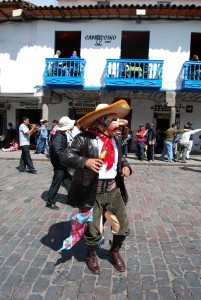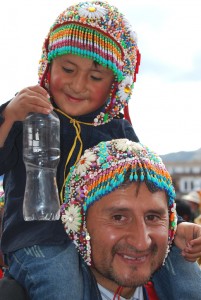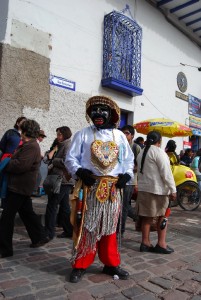Dances of Corpus Christi

Dance is a vital cultural expression in today’s Cuzco and there is almost no celebration without dancers. This is especially true of the patronal feasts with high religious character, as well as of those of the production cycle. Dancing is also found in carnival, anniversaries and private celebrations.
Some of the dances practiced today are centuries old and keep finding renewal through time. These include those named chuchus, ukukus, and k’achampa. Others have arisen since colonial times as expressions of mestizo art, sometimes with an ironic twist on European elements. These include the collas, chunchu, majeño, negritos, zambitos, etc.
During Corpus Christi each of the saints and virgins has a dance troupe to accompany them from their home chapel to the city’s main square. There they gather and perform a procession while a great multitude of people accompanies them on their rounds.

The most well known of the dances and the most performed for this feast are:
QHAPAQ QOLLA:

This dance originates from the following tradition. A lady from Paucartambo, in one of her trips to Pucará in the state of Puno in order to sell her prodects, found the head of an image of the Virgin of Carmen in the room where she stayed. She brought it back to Paucartambo and had a body made for the head in order to donate it to the Church. This trade was made by the Colla merchants (people of Puno) who lived in Paucartambo and thus the dance originated and represents them. It carries a great deal of social content and of faith in the “Mamacha” Carmen, especially for those who sing and dance for her, and make her happy in their mock battle.

The dancers wear beautifully adorned hats (monteras) of incalculable value, as well a a hand-knitted, face covering cap (waq’ollo) and a rectangular carrying cloth (lliqlla) handmade from vicuña wool. On their backs they carry a burden (q’ipi) containing a dried vicuña, a wild relative of the alpaca with unbelievably fine wool.
The main characters are the mayor (alcalde) the chief of the group, two captains–one for each line, (imilla–an aymara word for girl), and a boy (qollita) who is the son of the mayor and his wife.

The sweet and charming music is performed by an band which must know the choreography that consists of eleven movements with lots of changes. The dancers interpret sad songs that have great religious, social, and festive content at the same time they have a characteristic sadness, they are also happy since they bring play and laughter into the festivities.
MAJEÑO: This is a mestizo dance. Since Paucartambo was not a great producer of sugar cane, it imported aguardiente–a kind of fire water– from the lowland zone of Majes in Arequipa. It was brought by muleteers. This situation became the historical seed for the dance.

Its personages are an old man from Majes (majeño) who is a boss and dances with a lady who is elegantly dressed. Dependent on them are the other majeños and they are all entertained by the maqt’as, clowns. They all wear straw hats and a light cloth covers part of their face with happy expressions. They also wear leather jackets, a long-sleeved shirt and tie, artistically decorated belts, riding pants, boots with spurs attached, scarves for the road, and a bottle of wine or beer in hand. They dance happily to the tunes of a band of musicians who walk behind the virgin or saints on their path.
K’ACHAMPA: This dance represents Inca warriors and as a result has a pre-Hispanic origin. It is drawn from the Inca conquests and must be executed by dancers in excellent, athletic, condition. They show rhythm, bravery, and art with great preciseness. Its main personages are two captains who, in turn, each lead a row of soldiers called k’achampas.
The costumes consist of a round hat (montera), knit caps (chullus) decorated with white buttons, a decorated shirt and vest, short wool pants embroidered with silk threads, socks and white shoes. They also carry slings for fighting (warak’as), a bag (ch’uspa), and a large coat (tablacasaca). Its music is made from a native band playing whistles, snare drum, and bass drum. Their choreography has 7 movements.
CONTRADANZA: A mestizo agricultural dance, the contradanza’s origins are found in the Republican period, after independence from Spain, although it has colonial roots. It represents the customs of a social-historical world whose main figure is the machu or caporal, the old man or boss, protected by his soldiers and maqt’as, clowns. They carry out 10 different steps or movements as their choreography develops to the music performed on typical instruments.

The caporal wears a multicolored costume, with a mask having a prominent, extended nose and an artistically decorated mallet. The soldiers wear a knit cap (chullu), armor, and pants, all artistically decorated with precious stones, beads, and sequins, giving a overwhelming grace and power.
Besides the dances at Corpus Christi, the saints and virgins are also accompanied by musical groups, often composed of twenty or more musicians, who wear uniforms and perform their own choreography. Together with the dancers they bring joy to all who watch the processions of the saints.










